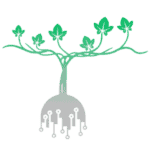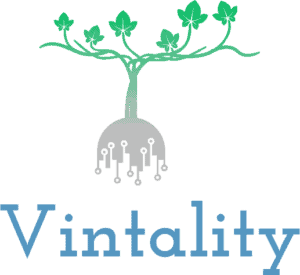Farming Profitably,
Making Great Wine
Vintality is pioneering sustainable growth by empowering growth with innovative agricultural technology solutions, services, and expertise.
Want to discuss your goals with us directly?
What are you looking for?
Goals
We are seeing significant climate chaos and variation.
Heat stress, cold snaps, late frosts…
You need a vineyard that can best handle the extremes that we see more and more of.
For us, the first step is a focus on the hidden half – the underground. Specifically, on working to expand the root structure. From there, we work to build a vineyard and system that can handle what Mother Nature is throwing at us.
Whether you’re wanting to become certified organic, regenerative, sustainable, or any other certification we’re here to support.
From working on application requirements, such as mapping irrigation and riparian zones, to supporting the team through the application process, we help achieve your certification goals.
We also work with clients who wish to casually follow specific practices, without receiving formal certification.
What details and data should you be paying attention to?
What are leading and lagging indicators? What factors are driving your vineyard’s performance? What should you focus on – and more importantly perhaps, what should you ignore?
We believe establishing benchmarks and key performance indicators (KPIs) is a critical tool in understanding and improving vineyard performance.
All data is approximate, none is perfect. But by drilling down into causative factors, we can simplify the goals of the vineyard and help the broader team understand the fundamental needs.
For example, we often find soil organic matter is a useful metric for capturing soil health, performance, and vine nutrient availability. While it is not the be-all-end-all, it provides simple, understandable, and useful KPI to improve vineyard sustainability, health, and performance.
A common request is to better understand the variability present within a vineyard.
Vineyards are artificial blocks – it has to be this way of course. But the soil and microclimate are not. This introduces variation that does not fit our neat designs.
Using modern technology – whether terroir mapping or multispectral – we can delineate where these zones are.
This means maybe picking the south half of a block a week earlier than the north. A tractor driver having extra compost application rates logged on his phone. Knowing where you need to prune more aggressively, or why in this block section you should plan for a fuller canopy.
It’s about bringing the vineyard into balance, improving yield and quality, without adding more work.
Having specific problem areas can be extremely frustrating. Especially with an annual cycle that only gives you so many chances to try solutions and watch for success.
We work with our clients to accurately identify areas, and either propose an immediate solution or to thoroughly test solutiosn.
Our most common experience is with our Terroir Mapping, where we have repeated aha moments: “THAT’S why the area was struggling!”
We understand the need to improve yield. It not only brings in more revenue, but is also a reflection of overall vineyard health.
Further, there are declining yield pressures in almost all winegrowing regions due to climate change.
But yield can be improved, and it is possible by addressing the fundamental pressures and challenges that are limiting it.
There has been a strong push for premiumisation in the wine industry, and with good reason. Vineyards and wineries are businesses, and we understand this.
And it’s not just about increasing profitability (which is important), but also the simple quality of the product we produce. We work with clients who aren’t interested in increasing the price of their bottle, just the quality of the product in it.
Achieving a more premium product is a key outcome of precision techniques. It means using technology to aid your team in finding and understand what, where and why high-quality fruit is being (or can be) produced.
Labour, both finding it and it’s cost, have become a major challenge for all farming systems.
Finding ways to reduce it – through automation, internal systems, or simple but innovative technology – is a key to profitability and getting the vineyard work done in today’s world.
We support our clients by identifying Management Zones – which improve labour efficiency, help determine sampling and picking timing, and allow tractor operators to drop just the right compost using only their phone.
We provide innovative trellising which, in a survey of French farmers, saved 30% of time shoot tucking.
And we provide a host of other services and products to help our clients reduce labour needs.
The best practices and practical research can be a huge boon to farmers and winemakers. Most want to stay up-to-date with how the wine world is improving and changing.
For example, there are new deficit irrigation tools and very cool research on annual irrigation timing being published.
But who has the time?
One of our core values, and skillsets, is education. We pride ourselves on supporting both clients and the broader industry with information, resources, and tools.
Whether working with us directly, reading our newsletter, or listening to our podcasts and other media, we believe in helping the industry staying abreast of best practices.
One of the greatest challenges we see with clients is connecting the two halves of the operation.
How often do you see winemakers who only set foot in a vineyard twice a year? Or vineyard managers who have no idea what qualities the winemakers is after?
To achieve success, we need to be working together. We support winemakers in understanding how the vineyard conditions are affecting the fruit their seeing in the winery.
And we assist vineyard operators in understanding what the winemaker is looking for – and what is (and isn’t) bringing these qualities out in their fruit.
We are coaches, not answering machines. We exist to support your team, not replace it or have all the answers. A great coach understands what a person or a team needs, and seeks to maximize their ability to reach those goals.
That’s our role, and one we’re always excited to fulfill.
Irrigation is not a simple thing to understand. In large part because it happens beneath our feet, in the hidden half of the vineyard we cannot see. (At least not without a backhoe!)
Implementing both effective and sustainable irrigation strategies is becoming more important necessary than ever.
Whether out of climate consciousness, in response to regulation, or out of a desire to improve crop yield and quality, irrigation is perhaps the most powerful tool in a vineyard’s arsenal.
We support our clients in understanding and more efficiently unlocking this powerful tool.
Those outside the wine industry do not appreciate how important vineyard balance is to winegrowers.
Unbalance increases labour costs, gives your vineyard manager headaches, reduces quality, and poses all sorts of other challenges.
We work with our clients to get to the root of what is causing unbalance and to bring the vineyard into a more easily managed state.
Whether using precision fertilisation techniques, tweaking irrigation scheduling, creating Management Zones, or a host of other solutions – the answer exists.
Winegrowing is a challenging business. You’re attempting to balance fifty different tasks at any one time, and you have a team and capital assets… and a crop that is responding to something totally out of your control – Mother Nature.
We are coaches. We are here to help you and your team identify and achieve your goals. Whether increasing yield, reducing labour costs, or whatever else – we’re here to help.
Our Tools
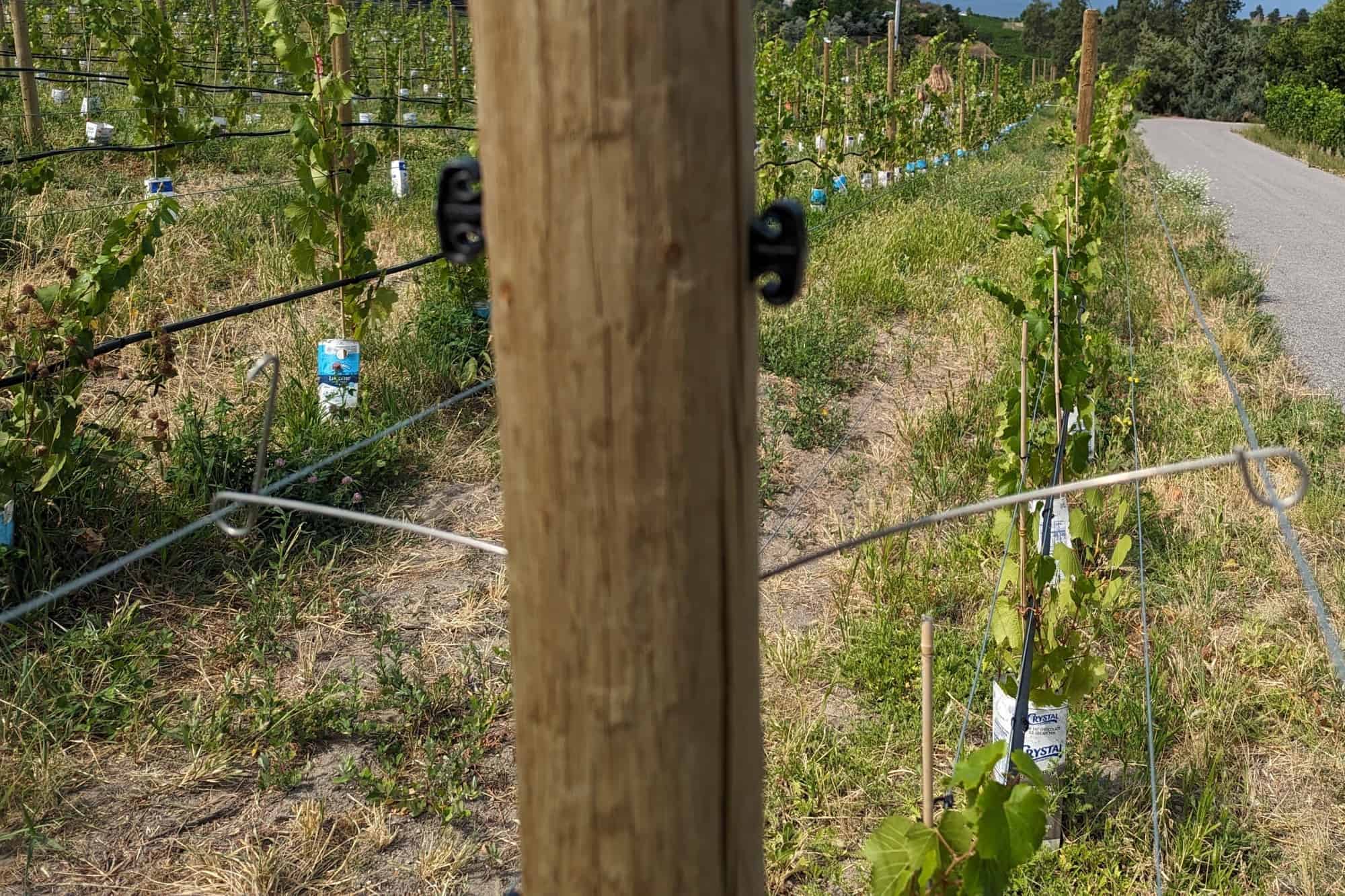
French Trellising
Innovative Trellising for a Better Crop, With Less Labour
French trellising designed by, and for, French farmers. Manufactured in France, from Dutch steel.
Focused on what actually works, and what’s actually needed. All guaranteed for 10 (galva) and 25 (stainless) years. If it breaks? We replace it.
Who else stands behind quality like that?
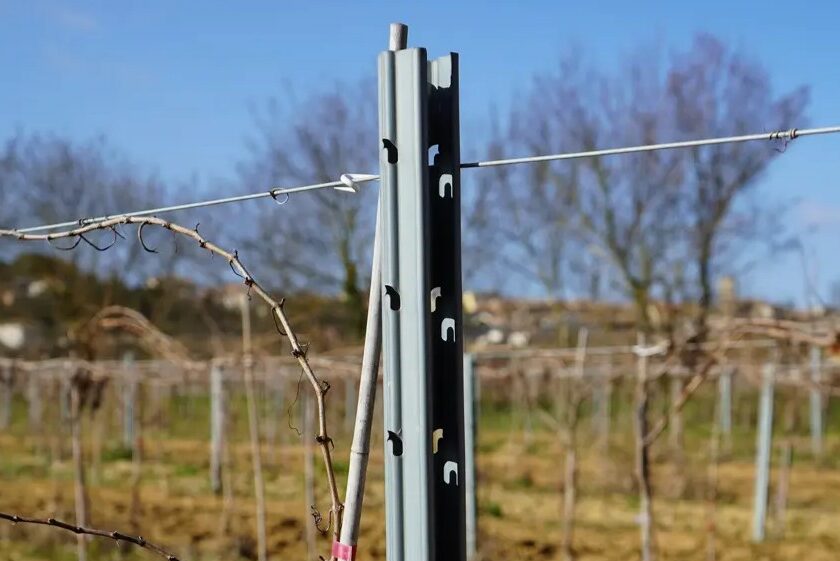
Spanish Posts
European Quality, Competitive Pricing
We now supply steel posts by a well-respected Spanish company, Magon.
The steel is European and the manufacture Spanish. The posts represent excellent quality at prices that are very competitive.
No more cheap Chinese posts that break and bend. Quality, at a good price.
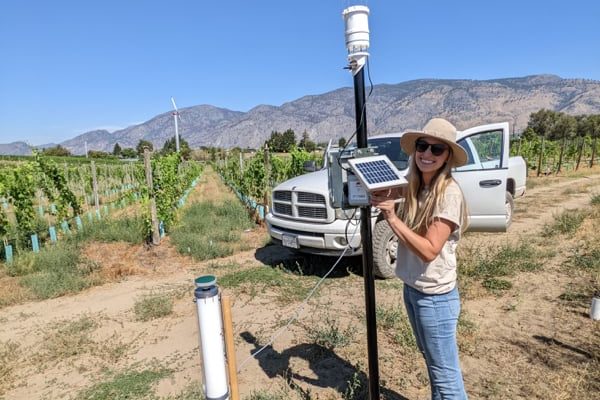
Irrigation Platform
Coming Soon: A Precision Irrigation Platform
Having encountered numerous issues with irrigation systems with our clients, and never finding a solution that worked, we had to build our own.
We’ve seen vineyards remove thir over-complicated and under-performing irrigation platforms for “dumb” systems.
There is a middle way, that is farmer-focused while reducing labour and improving plant health and yield. That’s what we’ve built, and we’re excited to share.
What’s needed isn’t a pretty map or fancy new technology – it’s the solution to the problem. The solution that achieves the goal.
With our clients – that’s our focus. Solutions. Problem solving.
Solutions
Another holistic solution that involves piecing together the many parts of vineyard operations.
The goal is simple – build plant resiliency to ensure longer term plant health (increasing profitability) in the face of extreme weather events.
A resilient, robust plant will not only make better fruit, but will handle extreme heat and cold more successfully.
For us, this begins with strategies to encourage deep rooting. This not only gives the plant access to more nutrient, water, and microbial resources but further provides more storage during challenging events. A bigger “bank”.
We accomplish this by understanding the soil, the potential, and building irrigation and other strategies to maximize this outcome.
This is where plant resiliency begins (but not ends).
Cover cropping has become a power Swiss army knife in improving soil and plant health.
From reducing compaction to improving nitrogen cycling to reducing herbicide use – the benefits and uses of cover crops are varied.
Our clients have a wide range of experience and interest in cover cropping and where appropriate, we work to integrate into broader management planning.
These activities encompass a wide range of the work we do with clients.
From irrigation audits to our precision irrigation system to annual scheduling and terroir mapping…
One of our core beliefs is that in irrigated systems – irrigation is the #1 driver of performance. The affects on vine health and wine quality are significant and many symptoms are downstream of irrigation issues.
Appropriate fertilisation is a key component for continued farm production and quality.
We used to believe it to be the number one tool in managing yield and quality, we’ve now realised this is far trumped by irrigation.
But there are significant affects that over- or under-fertilising still have. And there are important strategies that need to be incorporated. For example, we often see foliar as as superior strategy to soil-applied fertilisers.
Our solutions here encompass soil mapping, our specialized bioavailability sampling,
It can also incorporate reducing
Geographic Information System (GIS) is the use of GPS and other instruments to map various physical features in the world.
This can be as simple as accurately mapping row lengths and acreages for crop prediction, or creating attractive maps for certificate application or use in the tasting room or other marketing.
Coupled with other tools like soil mapping it can be used to model water flow over a property or identify frost pockets or other features.
The uses of GIS technology is broad and valuable.
Through both our own research and development work as well as work with clients, we have developed an expertise in identifying and securing grants for clients.
In 2023, we helped clients secure over $364,000 in grant funding – free cash in pocket for our clients.
We now offer a service helping you identify and acquire grants – for whatever activities you’re looking to engage in.
We’ve helped secure grants to cover compost purchases, irrigation system purchases, soil mapping, soil sampling, netting, compost spreaders, and much more.
Labour has become a major issue across the wine world. We feel fortunate to have discovered SCDC, a French trellising company that works the way we do. They have farm clients approach them with issues – and then they come up with a system.
We provide their full range of products – from spreaders to end posts to irrigation hangers to netting, heated cabling, you name it.
Their simple but genius tools reduce your labour hours. In a survey of their clients, they heard their spreaders saved on average 30%.
Unlike most UAV companies, we are farmers first and UAV pilots second. We waited years to get into drone mapping until the technology had matured enough to bring real value to farmers.
We use multispectral as a key tool in providing a holistic look at vineyard health and performance – particularly over time.
It allows the creation of Management Zones which can significantly improve labour efficiency and crop production. It is the current gold standard in yield estimation. And it allows annual monitoring of overall vine health as well as disease and other pockets.
There is a reason that it is popular in a soil and terroir-focused country like France (which is also where we have learned many of our techniques).
We kept banging into problems with clients that, when traced back, led to irrigation.
Often, the challenges were in the system themselves. They were labour intensive. And if they were “smart” irrigation systems, seemed to be built by and for engineers.They lacked the basic functions that a farm-hardened system needs – while also having the tools to make irrigation easier for better results.
So that’s why we developed our system – with and for our clients. For those who need a smarter system that actually works on a farm. And does so with some smarts, that doesn’t make your life harder.
Precision viticulture forms the basis of the work we do. It’s about leveraging technology in the service of our clients’ goals.
Fundamentally, we seek to marry new technology with old farming approaches. It’s about using technology in service of talented people, not to replace or over-complicate.
We use our precision viticulture tools – whether GPS, drones, or Chemboxes – to farm more profitably and make better fruit.
As part of our work, we have used numerous different sensors in pursuit of our client’s goals and aspirations.
This can involve different types of soil moisture sensors and weather stations, or multiple temperature sensors to help determine varietal locations.
These tools serve specific purposes. No sensor is perfect (soil moisture sensors all have weaknesses), but with their limitations well understood they can support the right vineyard site.
A grab bag of solutions (and a package we offer), site preparation and assessment is about two things:
- Determining the suitability and potential of an unplanted site
- Finding the best ways to maximize a planted or unplanted site
This first involves ruling out “no go’s” in a potential site. Are there major toxicity issues? Is there an underground river not visible to the eye? We’ve seen this happen a few times in our work resulting in either low value varietals planted in those areas or an abandonment of a potential purchase (which would’ve been a money sink for the client).
The second goal is find where to put the right varietals and rootstocks. Or in the case of a planted site, how to best manage current production. Perhaps a single block of Cabernet Franc should be split up into a premium and table wine sub-block?
The goal ultimately is to avoid red flags and maximize what exists through a variety of tools.
We specialise in both standard and bioavailability sampling. Many of the talks we have given revolve around the evaluation and challenges of understanding the soil beneath our feet.
We work with clients on choosing the appropriate tests, evaluating and implementing the results.
Increasingly this is involving evaluating the soil microbial community, although this work (and research) is in it’s early stages. We encourage clients to use this data, but understand it’s current limitations as we still have so much to understand about the soil community.
The greatest single service we provide is our terroir mapping. We use a special electrical conductivity (EC) instrument to measure the subsoil to one-and-a-half meters to identify soil conditions and vine performance.
This work identifies soil texture and water availability at the vineyard scale. Scientific research has repeatedly shown, and we see with our clients, the impact that this terroir mapping has on wine characteristics and quality.
The data is then ground truthed with soil pits which reveals the half of the vineyard we never see.
This is the solution we always see a “Oh now this makes sense!” from our clients. It is a must for every future and planted vineyard.
In many regions, crop protection from both deep winter freezes and spring frosts have become an issue. And as a warmer climate has allowed us to expand winegrowing regions – it has also pushed into more regions where this occurs, but not predictably.
We provide specialised snow netting and heated cabling to guard against both winter damage and frost.
Unlike geotextiles, the netting is left on year-round in special receivers at the top of the post. It takes far less labour to unravel and re-hook, simply having to be pulled down to a receiver at the bottom of the trellising or hooked into one at the top.
The snow netter may also double as heat shade, with one panel (on the sun side) being unraveled during extreme heat events.
The heated cabling works in conjunction, helping to keep sap and buds warm during cold events. It also may serve to warm the plant and accelerate ripening during cold summer and falls.
Service Packages
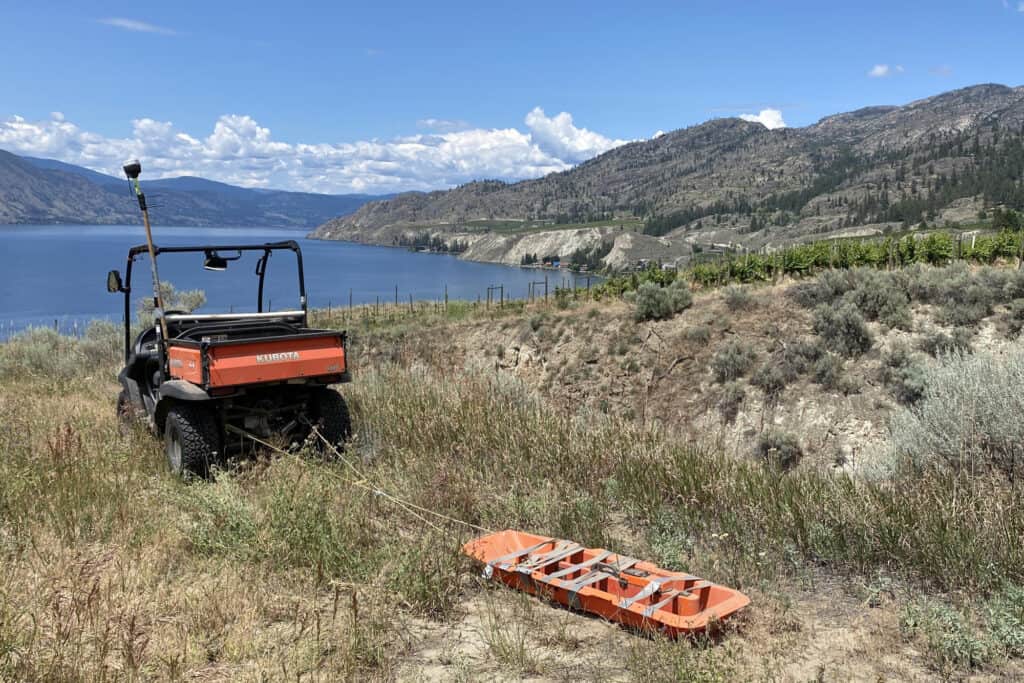
Site Assessment&Preparation
A proper site assessment can save you hundreds of thousands and significantly elevate the future wine. On planted sites, it can reduce labour, improve quality, and solve troubling problem areas.
- To assess the feasibility and potential of a new or planted vineyard site.
- To have Benchmarks to better inform planting decision and future management; to evaluate performance.
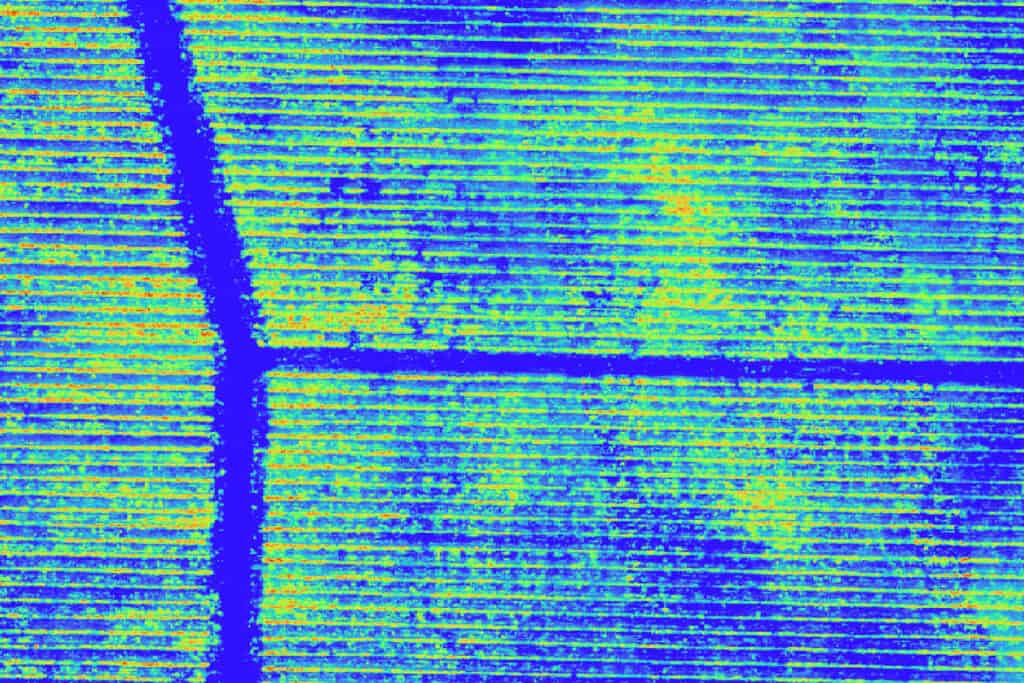
Vineyard Health &Diagnostics
We specialize in vineyard health and diagnostics using advanced remote sensing technology and data analysis. By providing detailed insights into soil composition, vine stress, and microclimatic conditions, we empower vineyard owners to make informed decisions for optimal vine health, resilience, and yield.
- To improve the resilience of the vine to climate extremes.
- To improve vineyard health benchmarks to achieve vineyard goals.
- To identify and improve lagging areas.
- Reduce labour (and improve quality) through Management Zones.
Related: SCDC Trellising, Precision Fertilisation
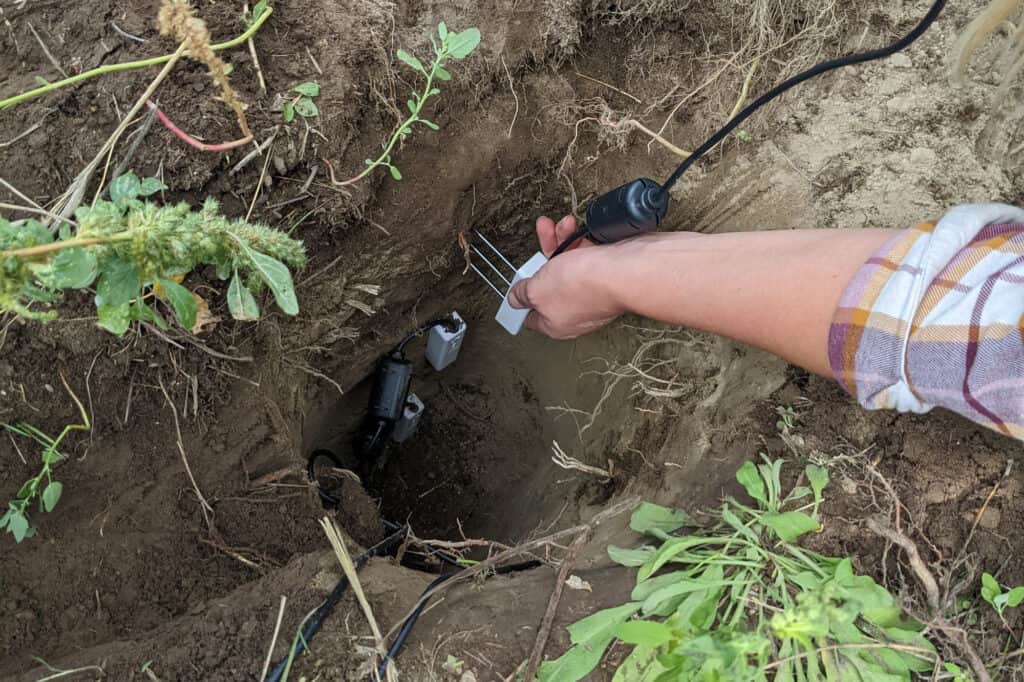
Irrigation Audit &
Precision Irrigation System
We’ve come to believe that in irrigated vineyards, irrigation is the #1 driver of vineyard health and performance. Achieving vine health and premium fruit is only possible with the right irrigation – and many downstream symptoms are caused by irrigation issues.
- To improve the fundamental issue in most irrigated vineyard systems.
- To provide tools and data to support appropriate irrigation.
- To reduce water usage while improving vineyard performance.
- To improve winemaking outcomes which are heavily influenced by irrigation.
